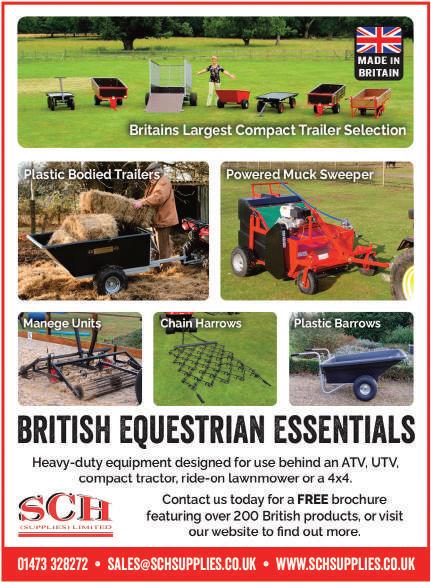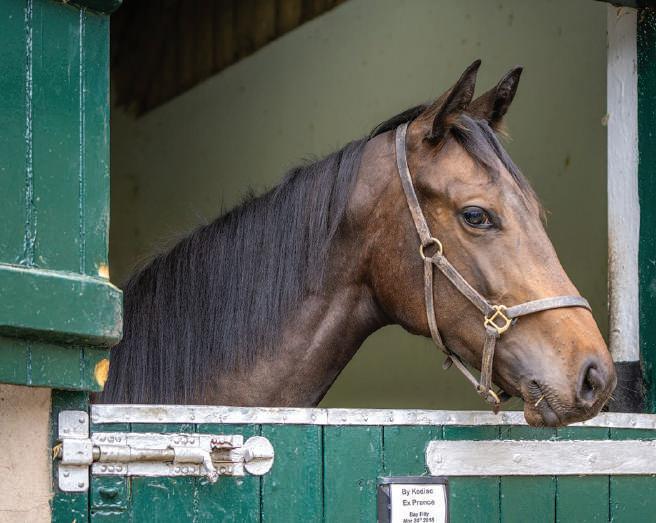
8 minute read
Stables, Yards, Arenas and
By Cheryl Johns
BASIC YARD BIOSECURITY PROTOCOLS
Advertisement
As an ambassador for Redwings Strangles Awareness Week, LiveryList is a huge advocate for both yard owners and horse owners understanding the risks of infectious disease on their yards, and the steps they can take to reduce the likelihood of an outbreak.
The Covid pandemic has gone a long way to help the general population better understand the way that infectious diseases and virusus can be spread, and to have a better understanding of prevention methods. This better understanding means more and more yards are thinking about biosecurity measures when considering the movement of horses on their yard. Whatever type of yard you have, there will always be a risk of infectious disease. This is not limited to Strangles, but also other infectious diseases such as Equine Flu and Equine Herpes (EHV), be this from new arrivals, people travelling to events, or visitors to the yard. Whilst isolation is not always possible on yards, at least some basic biosecurity protocols can help:
• Where possible, isolate new
arrivals to the yard in an area providing stabling and grazing separate to the main yard, and no sharing of tools or equipment
• Ensure new arrivals to the yard are fully vaccinated, wormed and consider requesting strangles testing • Know the resting temperature
of all equines in your care and make routine checks so that any signs of fever can be spotted immediately
• Avoid the sharing of tack and
equipment, especially at shows or events. Taking your own equipment such as feed and water buckets is best practice
• Consider hygiene protocols for visitors to the yard,
especially if they may come into contact with lots of equines (ie farriers, or instructors)
• Avoid nose to nose contact of equines not on the same
yard, such as out hacking, or at events and shows
• If it’s not possible to isolate when you return from an event or show, consider regular
temperature testing in line with FEI guidance
• If you hire out your facilities or hold events at your yard, consider limiting access to
areas of the yard to reduce cross contamination
• Have a process in place for notifying a suspected
outbreak, and open lines of communication between yard owner and horse owners The cost of an outbreak can be huge to a yard owner and their livery clients both financially and in terms of disruption, so although it may seem inconvenient taking these steps

STOP
INFECTIOUS DISEASE
SINCE ITS LAUNCH IN 2011, UK LIVERY YARD DIRECTORY ‘LIVERYLIST’ HAS DEVELOPED TO ALSO BECOME A UNIQUE AND INDESPENSIBLE RESOURCE FOR YARD OWNERS, OFFERING GUIDANCE, RESOURCES AND SUPPORT ON ALL ASPECTS OF YARD MANAGEMENT
it can be hugely beneficial in the long run if it prevents even just one or two cases on a yard. With Redwings having raised the awareness of infectious diseases since the launch of their #StampOutStrangles campaign in 2018, this has helped lessen the stigma of outbreaks, and what was once an incident kept behind closed doors is becoming more widely spoken about, leading to more horse owners asking about biosecurity when considering livery yards. The most effective steps to preventing an outbreak of infectious disease is simply good stable management and biosecurity practices. We would encourage all yard owners to consider the movement of horses on their yard, and the steps they can take to best protect themselves.
www.liverylist.co.uk/ resources

THE SUN IS SHINING...
With performance sport horses it’s all about gaining that extra marginal edge for a competitive advantage. With breeding, diet, rider techniques and knowledge we have almost reached the limit of perfecting our horses’ condition for competition. This is where light therapy comes in; to boost serotonin levels and give your horse that winning edge.
HorseLight have developed an advanced, light therapy system. The sun/daylight delivers a specific spectrum of blue light which has been scientifically proven to enhance the performance, health and wellbeing of horses. The key benefits for performance sports horses are significant. These finely tuned horses can work more effectively, and their improved daylight alertness can leave them feeling more awake, more focused, and importantly, much happier. Prices start from £199 (+vat).
www.horselight.co.uk
CLEARING PADDOCKS


Every smallholding and private paddock are different, but clearing up after horses, donkeys or ponies is something we all have in common.
Created out of necessity, the SCH Equestrian Powered Brush (EPB) is for customers requesting something –anything – to make this perpetual and relentless task quicker and easier. Over the past 35 years, SCH has created and refined many equestrian machines, but none more useful than the EPB, which will allow you to spend longer with the horses and less time clearing up. The regular removal of droppings promotes healthy grass and reduces dropping related diseases. Four rows of height adjustable brushes rotate at variable speeds to flick the droppings into the plastic rotproof rear collecting box. A reliable 5.5Hp Honda engine drives four rows of heightadjustable brushes. The machines speed-reduction gearbox incorporates a centrifugal clutch which allows the brushes to stop revolving when the engine speed is low - a necessary feature when moving from heap to heap. To use the EPB simply tow it over the droppings and the powered brush will pick them cleanly off the ground and throw them into the rear collection box. Emptying couldn’t be easier –turn the winch to effortlessly lift and tilt the collecting box. The task of dropping removal never ends, and the EPB can potentially save hundreds of hours of labour per year. The durable chassis is constructed from solid welded steel, and the Honda-built engine offers maximum reliability. When combined with SCH’s dedicated spare parts team, the robust British-made machinery will save you time and cost in labour for many years to come. For a free 80 page brochure featuring over 200 British built machines designed explicitly for smallholders, contact SCH.
www.schsupplies.co.uk

Details of the recent Bedmax National Equine Health Survey reports that more than 45% of the 993 owners who completed the survey had horses that had suffered a health problem (as opposed to an injury) that required box rest and/or veterinary treatment.
Asked to identify the nature of the problem, just over 30% reported that it was respiratory health or disease. All previous Bedmax Equine Health surveys have given similar results, and owners clearly understand the primary cause. The Equine Vet, Peter ‘Spike’ Milligan, says that respiratory health is fundamental to a horse’s wellbeing. “If not properly treated and managed there can be long term effects on the lungs that can reduce life expectancy in some horses. Apart from equine flu and the herpes virus, the most common respiratory problems are multifactorial, but the inhalation of airborne particles and the irritation to the mucosal lining of the respiratory tract is one very common factor.” Respondents confirmed overwhelmingly that safeguarding their horse’s health is paramount when choosing bedding, and their priority is choosing one with the lowest airborne dust levels. The survey found that 90% of horses are either kept at home or at DIY Livery, with leisure riding the most popular equine activity. Hygiene was also a key priority in respondents’ choice of bedding, underlining growing concerns over biosecurity in stables where most horses spend at least half their lives. Over 70% of owners confirmed that in the winter months they keep their horses in the stable for a minimum of twelve hours out of every twentyfour. The cost of equine health problems was also a significant issue. Of the 520 owners responding to the request to indicate their veterinary costs for treating health problems, more than 40% paid over £1,000 for treatment; 22% paid over £2,000. Loss of use was also significant, as over 55% of owners experiencing equine health problems, said that their horses were on box rest and/or could not be ridden for more than a month. A positive trend identified from the survey was that after years of urging customers to compost their used bedding, Bedmax were delighted to find that over 90% of respondents are doing just that and allowing local farmers (66%) or gardeners
SURVEY
CONFIRMS: RESPIRATORY DISEASE REMAINS THE BIGGEST EQUINE HEALTH PROBLEM Overall, the top equine health problems suffered were: (25%) to return it to the soil. “Our annual survey is a really illuminating exercise as it helps us find out what horse owners are experiencing and what is30% Respiratory ill health really important to them,” said21% Laminitis Tim Smalley, Managing Director20% Arthritis of Bedmax. “It is interesting to12% Mud fever see that respiratory ailments10% Hoof disease, remain the most prevalentcracking, infection equine health problem. At Bedmax we make our shavings from fresh pine, which offers unique antibacterial action ...Hygiene was also a against harmful bacteria and key priority in fungi. We also dry our shavings respondents’ choice of at sterilising temperatures and vacuum extract every particle of bedding, underlining airborne dust we can during growing concerns over production, to help avoid this biosecurity in stables very problem. I am absolutely committed to producing the where most horses best possible horse bedding and spend at least half I am really proud of our team at their lives... Bedmax. Our recent NOPS accreditation is testament to our hard work, as we are the only producer so far to have this award.”
www.bedmaxshavings.com











